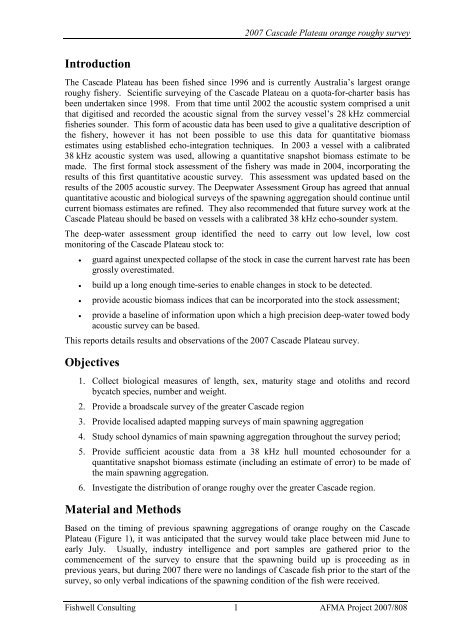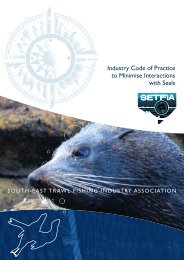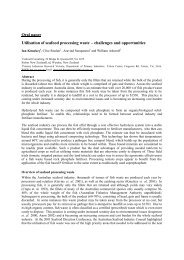Survey of orange roughy spawning aggregations on the Cascade ...
Survey of orange roughy spawning aggregations on the Cascade ...
Survey of orange roughy spawning aggregations on the Cascade ...
You also want an ePaper? Increase the reach of your titles
YUMPU automatically turns print PDFs into web optimized ePapers that Google loves.
2007 <strong>Cascade</strong> Plateau <str<strong>on</strong>g>orange</str<strong>on</strong>g> <str<strong>on</strong>g>roughy</str<strong>on</strong>g> survey<br />
Introducti<strong>on</strong><br />
The <strong>Cascade</strong> Plateau has been fished since 1996 and is currently Australia’s largest <str<strong>on</strong>g>orange</str<strong>on</strong>g><br />
<str<strong>on</strong>g>roughy</str<strong>on</strong>g> fishery. Scientific surveying <str<strong>on</strong>g>of</str<strong>on</strong>g> <strong>the</strong> <strong>Cascade</strong> Plateau <strong>on</strong> a quota-for-charter basis has<br />
been undertaken since 1998. From that time until 2002 <strong>the</strong> acoustic system comprised a unit<br />
that digitised and recorded <strong>the</strong> acoustic signal from <strong>the</strong> survey vessel’s 28 kHz commercial<br />
fisheries sounder. This form <str<strong>on</strong>g>of</str<strong>on</strong>g> acoustic data has been used to give a qualitative descripti<strong>on</strong> <str<strong>on</strong>g>of</str<strong>on</strong>g><br />
<strong>the</strong> fishery, however it has not been possible to use this data for quantitative biomass<br />
estimates using established echo-integrati<strong>on</strong> techniques. In 2003 a vessel with a calibrated<br />
38 kHz acoustic system was used, allowing a quantitative snapshot biomass estimate to be<br />
made. The first formal stock assessment <str<strong>on</strong>g>of</str<strong>on</strong>g> <strong>the</strong> fishery was made in 2004, incorporating <strong>the</strong><br />
results <str<strong>on</strong>g>of</str<strong>on</strong>g> this first quantitative acoustic survey. This assessment was updated based <strong>on</strong> <strong>the</strong><br />
results <str<strong>on</strong>g>of</str<strong>on</strong>g> <strong>the</strong> 2005 acoustic survey. The Deepwater Assessment Group has agreed that annual<br />
quantitative acoustic and biological surveys <str<strong>on</strong>g>of</str<strong>on</strong>g> <strong>the</strong> <str<strong>on</strong>g>spawning</str<strong>on</strong>g> aggregati<strong>on</strong> should c<strong>on</strong>tinue until<br />
current biomass estimates are refined. They also recommended that future survey work at <strong>the</strong><br />
<strong>Cascade</strong> Plateau should be based <strong>on</strong> vessels with a calibrated 38 kHz echo-sounder system.<br />
The deep-water assessment group identified <strong>the</strong> need to carry out low level, low cost<br />
m<strong>on</strong>itoring <str<strong>on</strong>g>of</str<strong>on</strong>g> <strong>the</strong> <strong>Cascade</strong> Plateau stock to:<br />
• guard against unexpected collapse <str<strong>on</strong>g>of</str<strong>on</strong>g> <strong>the</strong> stock in case <strong>the</strong> current harvest rate has been<br />
grossly overestimated.<br />
• build up a l<strong>on</strong>g enough time-series to enable changes in stock to be detected.<br />
• provide acoustic biomass indices that can be incorporated into <strong>the</strong> stock assessment;<br />
• provide a baseline <str<strong>on</strong>g>of</str<strong>on</strong>g> informati<strong>on</strong> up<strong>on</strong> which a high precisi<strong>on</strong> deep-water towed body<br />
acoustic survey can be based.<br />
This reports details results and observati<strong>on</strong>s <str<strong>on</strong>g>of</str<strong>on</strong>g> <strong>the</strong> 2007 <strong>Cascade</strong> Plateau survey.<br />
Objectives<br />
1. Collect biological measures <str<strong>on</strong>g>of</str<strong>on</strong>g> length, sex, maturity stage and otoliths and record<br />
bycatch species, number and weight.<br />
2. Provide a broadscale survey <str<strong>on</strong>g>of</str<strong>on</strong>g> <strong>the</strong> greater <strong>Cascade</strong> regi<strong>on</strong><br />
3. Provide localised adapted mapping surveys <str<strong>on</strong>g>of</str<strong>on</strong>g> main <str<strong>on</strong>g>spawning</str<strong>on</strong>g> aggregati<strong>on</strong><br />
4. Study school dynamics <str<strong>on</strong>g>of</str<strong>on</strong>g> main <str<strong>on</strong>g>spawning</str<strong>on</strong>g> aggregati<strong>on</strong> throughout <strong>the</strong> survey period;<br />
5. Provide sufficient acoustic data from a 38 kHz hull mounted echosounder for a<br />
quantitative snapshot biomass estimate (including an estimate <str<strong>on</strong>g>of</str<strong>on</strong>g> error) to be made <str<strong>on</strong>g>of</str<strong>on</strong>g><br />
<strong>the</strong> main <str<strong>on</strong>g>spawning</str<strong>on</strong>g> aggregati<strong>on</strong>.<br />
6. Investigate <strong>the</strong> distributi<strong>on</strong> <str<strong>on</strong>g>of</str<strong>on</strong>g> <str<strong>on</strong>g>orange</str<strong>on</strong>g> <str<strong>on</strong>g>roughy</str<strong>on</strong>g> over <strong>the</strong> greater <strong>Cascade</strong> regi<strong>on</strong>.<br />
Material and Methods<br />
Based <strong>on</strong> <strong>the</strong> timing <str<strong>on</strong>g>of</str<strong>on</strong>g> previous <str<strong>on</strong>g>spawning</str<strong>on</strong>g> <str<strong>on</strong>g>aggregati<strong>on</strong>s</str<strong>on</strong>g> <str<strong>on</strong>g>of</str<strong>on</strong>g> <str<strong>on</strong>g>orange</str<strong>on</strong>g> <str<strong>on</strong>g>roughy</str<strong>on</strong>g> <strong>on</strong> <strong>the</strong> <strong>Cascade</strong><br />
Plateau (Figure 1), it was anticipated that <strong>the</strong> survey would take place between mid June to<br />
early July. Usually, industry intelligence and port samples are ga<strong>the</strong>red prior to <strong>the</strong><br />
commencement <str<strong>on</strong>g>of</str<strong>on</strong>g> <strong>the</strong> survey to ensure that <strong>the</strong> <str<strong>on</strong>g>spawning</str<strong>on</strong>g> build up is proceeding as in<br />
previous years, but during 2007 <strong>the</strong>re were no landings <str<strong>on</strong>g>of</str<strong>on</strong>g> <strong>Cascade</strong> fish prior to <strong>the</strong> start <str<strong>on</strong>g>of</str<strong>on</strong>g> <strong>the</strong><br />
survey, so <strong>on</strong>ly verbal indicati<strong>on</strong>s <str<strong>on</strong>g>of</str<strong>on</strong>g> <strong>the</strong> <str<strong>on</strong>g>spawning</str<strong>on</strong>g> c<strong>on</strong>diti<strong>on</strong> <str<strong>on</strong>g>of</str<strong>on</strong>g> <strong>the</strong> fish were received.<br />
Fishwell C<strong>on</strong>sulting 1 AFMA Project 2007/808




